Manganese Modified Activated Alumina through Impregnation for Enhanced Adsorption Capacity of Fluoride Ions
Abstract
:1. Introduction
2. Materials and Methods
2.1. Materials
2.2. Preparation of the Adsorbent
2.3. Characterizations of the adsorbent
2.4. Adsorption Studies
2.4.1. Adsorption Kinetics
2.4.2. Thermodynamic Study
2.4.3. Effect of Coexisting Ions
3. Results and Discussion
3.1. Characterization of the Adsorbent
3.2. Comparison of Fresh Adsorbent with MAA
3.3. Effect of Parameters on Fluoride Removal
3.3.1. Effect of Competing for Co-Existing Anions on MAA
3.3.2. Effect of Contacting Time on MAA
3.3.3. Effect of Temperature on MAA
3.3.4. Effect of Initial pH on MAA
3.4. Kinetic Modeling
3.4.1. Quasi-First-Order Model and Quasi-Second Model
3.4.2. External Mass Transfer Process
3.4.3. Internal Mass Transfer Resistance
3.4.4. Adsorption onto the Active Sites
3.5. Isotherm Modeling
3.6. Effect of MAA on Fluoride Removal
3.7. Comparison to Literature
- Cost of per kg of activated alumina = 0.59–1.33 USD/kg
- Cost of per kg of chitosan = 13.35–14.83 USD/kg
- Cost of per kg of coconut shell activated carbon = 1.26–1.63 USD/kg
- Cost of per kg of red mud = 2.22–2.67 USD/kg
3.8. The Performance of MAA in Real Water
4. Conclusions
Supplementary Materials
Author Contributions
Funding
Institutional Review Board Statement
Informed Consent Statement
Data Availability Statement
Acknowledgments
Conflicts of Interest
References
- Lacson, C.F.Z.; Lu, M.-C.; Huang, Y.-H. Fluoride-containing water: A global perspective and a pursuit to sustainable water defluoridation management—An overview. J. Clean. Prod. 2020, 280, 124236. [Google Scholar] [CrossRef]
- Sternitzke, V.; Kaegi, R.; Audinot, J.-N.; Lewin, E.; Hering, J.G.; Johnson, C.A. Uptake of Fluoride from Aqueous Solution on Nano-Sized Hydroxyapatite: Examination of a Fluoridated Surface Layer. Environ. Sci. Technol. 2012, 46, 802. [Google Scholar] [CrossRef] [PubMed]
- Nagaraj, A.; Pillay, K.; Kumar, S.K.; Rajan, M. Dicarboxylic acid cross-linked metal ion decorated bentonite clay and chitosan for fluoride removal studies. RSC Adv. 2020, 10, 16791–16803. [Google Scholar] [CrossRef]
- Turner, B.D.; Binning, P.; Stipp, S.L.S. Fluoride removal by calcite: Evidence for fluorite precipitation and surface adsorption. Environ. Sci. Technol. 2005, 39, 9561–9568. [Google Scholar] [CrossRef] [PubMed]
- Yadav, K.K.; Kumar, S.; Pham, Q.B.; Gupta, N.; Rezania, S.; Kamyab, H.; Yadav, S.; Vymazal, J.; Kumar, V.; Tri, D.Q.; et al. Fluoride contamination, health problems and remediation methods in Asian groundwater: A comprehensive review. Ecotoxicol. Environ. Saf. 2019, 182, 109362. [Google Scholar] [CrossRef] [PubMed]
- Chen, X.; Wan, C.; Yu, R.; Meng, L.; Wang, D.; Chen, W.; Duan, T.; Li, L. A Novel Carboxylated Polyacrylonitrile Nanofibrous Membrane with High Adsorption Capacity for Fluoride Removal from Water. J. Hazard. Mater. 2021, 411, 125113. [Google Scholar] [CrossRef]
- Bo, Z.; Mei, H.; Yongsheng, Z.; Xueyu, L.; Xuelin, Z.; Jun, D. Distribution and Risk Assessment of Fluoride in Drinking Water in the West Plain Region of Jilin Province, China. Environ. Geochem. Health 2003, 25, 421–431. [Google Scholar] [CrossRef]
- Luo, W.; Gao, X.; Zhang, X. Geochemical processes controlling the groundwater chemistry and fluoride contamination in the yuncheng basin, Chinadan area with complex hydrogeochemical conditions. PLoS ONE 2018, 13, e0199082. [Google Scholar] [CrossRef]
- Viswanathan, N.; Meenakshi, S. Role of metal ion incorporation in ion exchange resin on the selectivity of fluoride. J. Hazard. Mater. 2009, 162, 920–930. [Google Scholar] [CrossRef]
- Li, Q.; Wang, B.; Li, W.; Wang, C.; Zhou, Q.; Shuang, C.; Li, A. Performance evaluation of magnetic anion exchange resin removing fluoride. J. Chem. Technol. Biotechnol. 2016, 91, 1747–1754. [Google Scholar] [CrossRef]
- Arahman, N.; Mulyati, S.; Lubis, M.R.; Takagi, R.; Matsuyama, H. The removal of fluoride from water based on applied current and membrane types in electrodialyis. J. Fluor. Chem. 2016, 191, 97–102. [Google Scholar] [CrossRef]
- Boubakri, A.; Bouchrit, R.; Hafiane, A.; Bouguecha, S.A. Fluoride removal from aqueous solution by direct contact membrane distillation: Theoretical and experimental studies. Environ. Sci. Pollut. Res. 2014, 21, 10493–10501. [Google Scholar] [CrossRef]
- Dhawane, S.H.; Khan, A.A.; Singh, K.; Tripathi, A.; Hasda, R.; Halder, G. Insight into Optimization, isotherm, kinetics, and thermodynamics of fluoride adsorption onto activated alumina. Environ. Prog. Sustain. 2018, 37, 766–776. [Google Scholar] [CrossRef]
- Kumari, U.; Behera, S.K.; Meikap, B.C. A novel acid modified alumina adsorbent with enhanced defluoridation property: Kinetics, isotherm study and applicability on industrial wastewater. J. Hazard. Mater. 2019, 365, 868–882. [Google Scholar] [CrossRef]
- Li, L.; Zhao, L.; Ma, J.; Tian, Y. Preparation of graphene oxide/chitosan complex and its adsorption properties for heavy metal ions. Green Process. Synth. 2020, 9, 294–303. [Google Scholar] [CrossRef]
- Tripathy, S.S.; Bersillon, J.L.; Gopal, K. Removal of fluoride from drinking water by adsorption onto alum-impregnated activated alumina. Sep. Purif. Technol. 2006, 50, 310–317. [Google Scholar] [CrossRef]
- Tripathy, S.S.; Raichur, A.M. Abatement of fluoride from water using manganese dioxide-coated activated alumina. J. Hazard. Mater. 2008, 153, 1043–1051. [Google Scholar] [CrossRef] [PubMed]
- Maliyekkal, S.M.; Shukla, S.; Philip, L.; Nambi, M. Enhanced fluoride removal from drinking water by magnesia-amended activated alumina granules. Chem. Eng. J. 2008, 140, 183–192. [Google Scholar] [CrossRef]
- Cheng, J.; Meng, X.; Jing, C.; Hao, J. La3+-modified activated alumina for fluoride removal from water. J. Hazard. Mater. 2014, 278, 343–349. [Google Scholar] [CrossRef]
- Lenoble, V.; Laclautre, C.; Serpaud, B.; Deluchat, V.; Bollinger, J.-C. As(V) retention and As(III) simultaneous oxidation and removal on a MnO2-loaded polystyrene resin. Sci. Total. Environ. 2004, 326, 197–207. [Google Scholar] [CrossRef]
- Bayoudh, A.; Etteyeb, N.; Kossai, R. Hydrothermal synthesis, characterization and electrochemical properties of γ-MnOOH nanobelts. Ceram. Int. 2015, 41, 12273–12279. [Google Scholar] [CrossRef]
- Maliyekkal, S.M.; Sharma, A.K.; Philip, L. Manganese-oxide-coated alumina: A promising sorbent for defluoridation of water. Water Res. 2006, 40, 3497–3506. [Google Scholar] [CrossRef] [PubMed]
- Guo, X.; Wang, J. Sorption of antibiotics onto aged microplastics in freshwater and seawater. Mar. Pollut. Bull. 2019, 149, 110511. [Google Scholar] [CrossRef] [PubMed]
- Jwa, B.; Xuan, G.A. Adsorption kinetic models: Physical meanings, applications, and solving methods. J. Hazard. Mater. 2020, 390, 122156. [Google Scholar] [CrossRef]
- Hu, Y.; Guo, X.; Chen, C.; Wang, J. Algal sorbent derived from Sargassum horneri for adsorption of cesium and strontium ions: Equilibrium, kinetics, and mass transfer. Appl. Microbiol. Biotechnol. 2019, 103, 2833–2843. [Google Scholar] [CrossRef] [PubMed]
- Ahmed, M.J.; Theydan, S.K. Microwave assisted preparation of microporous activated carbon from Siris seed pods for adsorption of metronidazole antibiotic. Chem. Eng. J. 2013, 214, 310–318. [Google Scholar] [CrossRef]
- Boyd, G.E.; Schubert, J.; Adamson, A.W. The exchange adsorption of ions from aqueous solutions by organic zeolites; Kinetics, J. Kinet. J. Am. Chem. Soc. 1947, 69, 2818. [Google Scholar] [CrossRef]
- Liu, Y.; Shen, L. From Langmuir kinetics to first- and second-order rate equations for adsorption. Langmuir 2008, 24, 11625–11630. [Google Scholar] [CrossRef]
- Varghese, S.P.; Babu, A.T.; Babu, B.; Antony, R. γ-MnOOH nanorods: Efficient adsorbent for removal of methylene blue from aqueous solutions. J. Water Process. Eng. 2017, 19, 1–7. [Google Scholar] [CrossRef]
- Shen, X.; Yan, F.; Li, C.; Qu, F.; Wang, Y.; Zhang, Z. Biogas Upgrading via Cyclic CO2 Adsorption: Application of Highly Regenerable PEI@nano-Al2O3 Adsorbents with Anti-Urea Properties. Environ. Sci. Technol. 2021, 55, 5236–5247. [Google Scholar] [CrossRef]
- Bochatay, L.; Persson, P.; Sjöberg, S. Metal ion coordination at the water-manganite (gamma-MnOOH) interface II. An EXAFS study of zinc(II). J. Colloid Interface Sci. 2000, 229, 584–592. [Google Scholar] [CrossRef] [PubMed]
- Pan, B.; Xu, J.; Wu, B.; Li, Z.; Liu, X. Enhanced Removal of Fluoride by Polystyrene Anion Exchanger Supported Hydrous Zirconium Oxide Nanoparticles. Environ. Sci. Technol. 2013, 47, 9347–9354. [Google Scholar] [CrossRef] [PubMed]
- Mahmoud, A.E.D.; Hosny, M.; El-Maghrabi, N.; Fawzy, M. Facile synthesis of reduced graphene oxide by Tecoma stans extracts for efficient removal of Ni (II) from water: Batch experiments and response surface methodology. Sustain. Environ. Res. 2022, 32, 22. [Google Scholar] [CrossRef]
- Mahmoud, A.E.D.; Al-Qahtani, K.M.; Alflaij, S.O.; Al-Qahtani, S.F.; Alsamhan, F.A. Green copper oxide nanoparticles for lead, nickel, and cadmium removal from contaminated water. Sci. Rep. 2021, 11, 12547. [Google Scholar] [CrossRef]
- You, K.; Li, P.; Fu, J.; Kang, N.; Gao, Y.; Cheng, X.; Yang, Y.; Yu, F. Fabrication of Manganese-Supported Activated Alumina Adsorbent for Defluoridation of Water: A Kinetics and Thermodynamics Study. Water 2021, 13, 1219. [Google Scholar] [CrossRef]
- Rayalu, D.S. Synthesis and characterization of lanthanum impregnated chitosan flakes for fluoride removal in water. Desalination 2011, 273, 267–275. [Google Scholar] [CrossRef]
- Dhanasekaran, P.; Sahu, O. Arsenate and fluoride removal from groundwater by sawdust impregnated ferric hydroxide and activated alumina (SFAA). Groundw. Sustain. Dev. 2021, 12, 100490. [Google Scholar] [CrossRef]
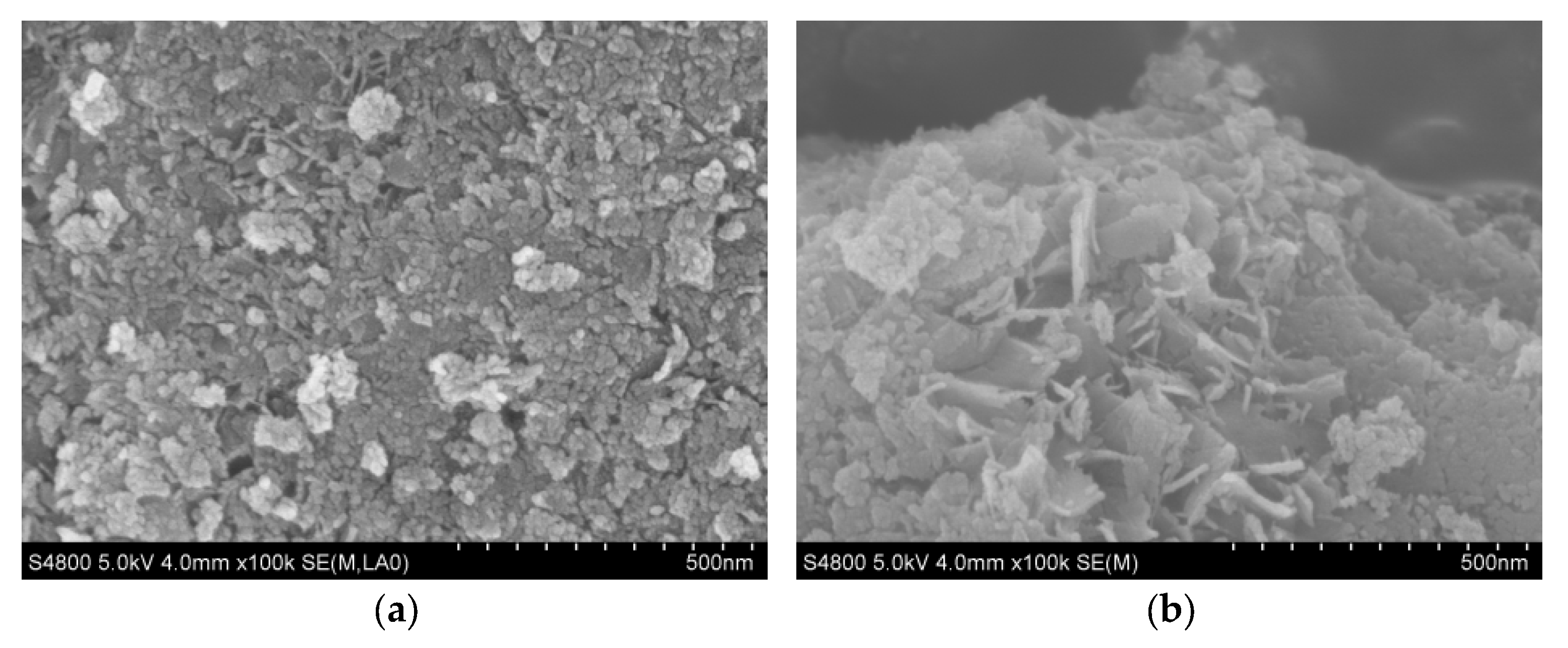
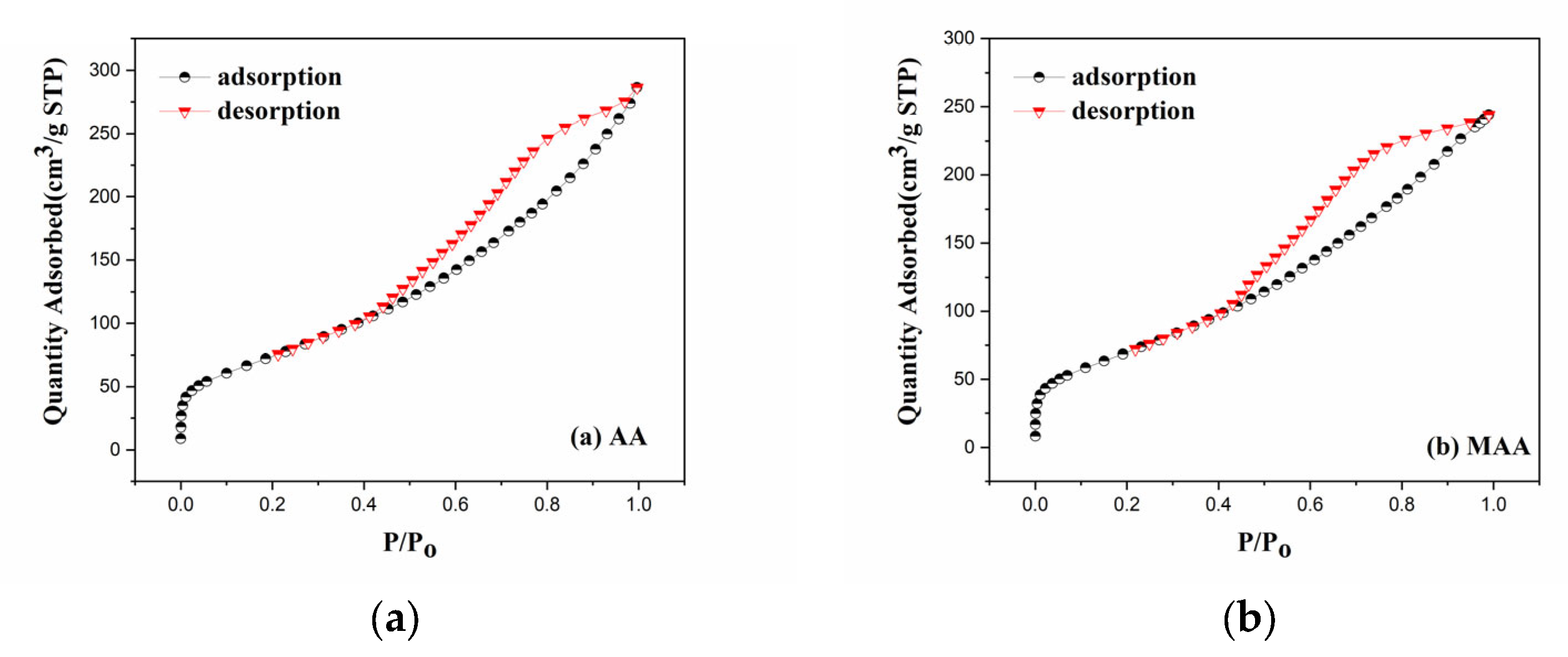
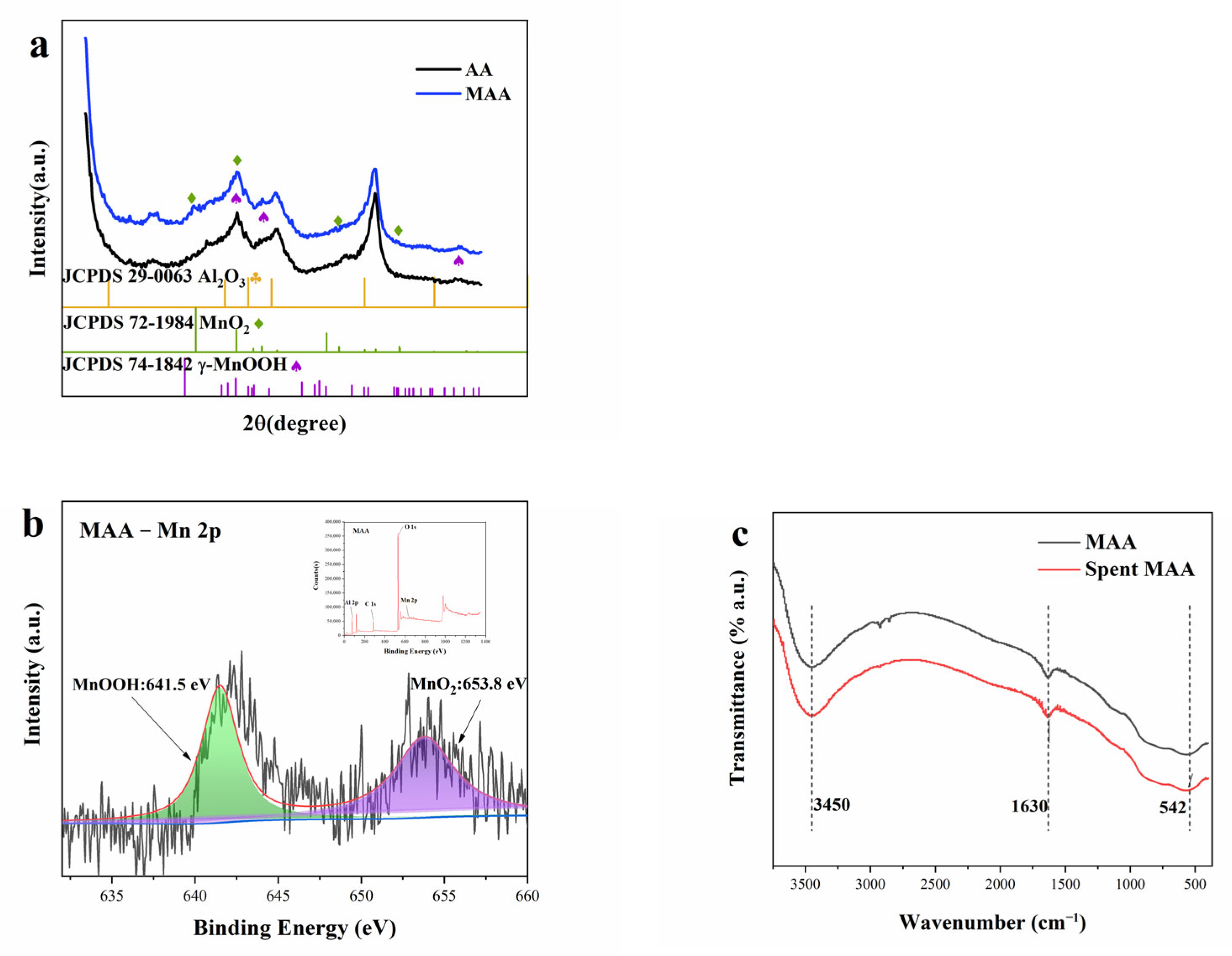
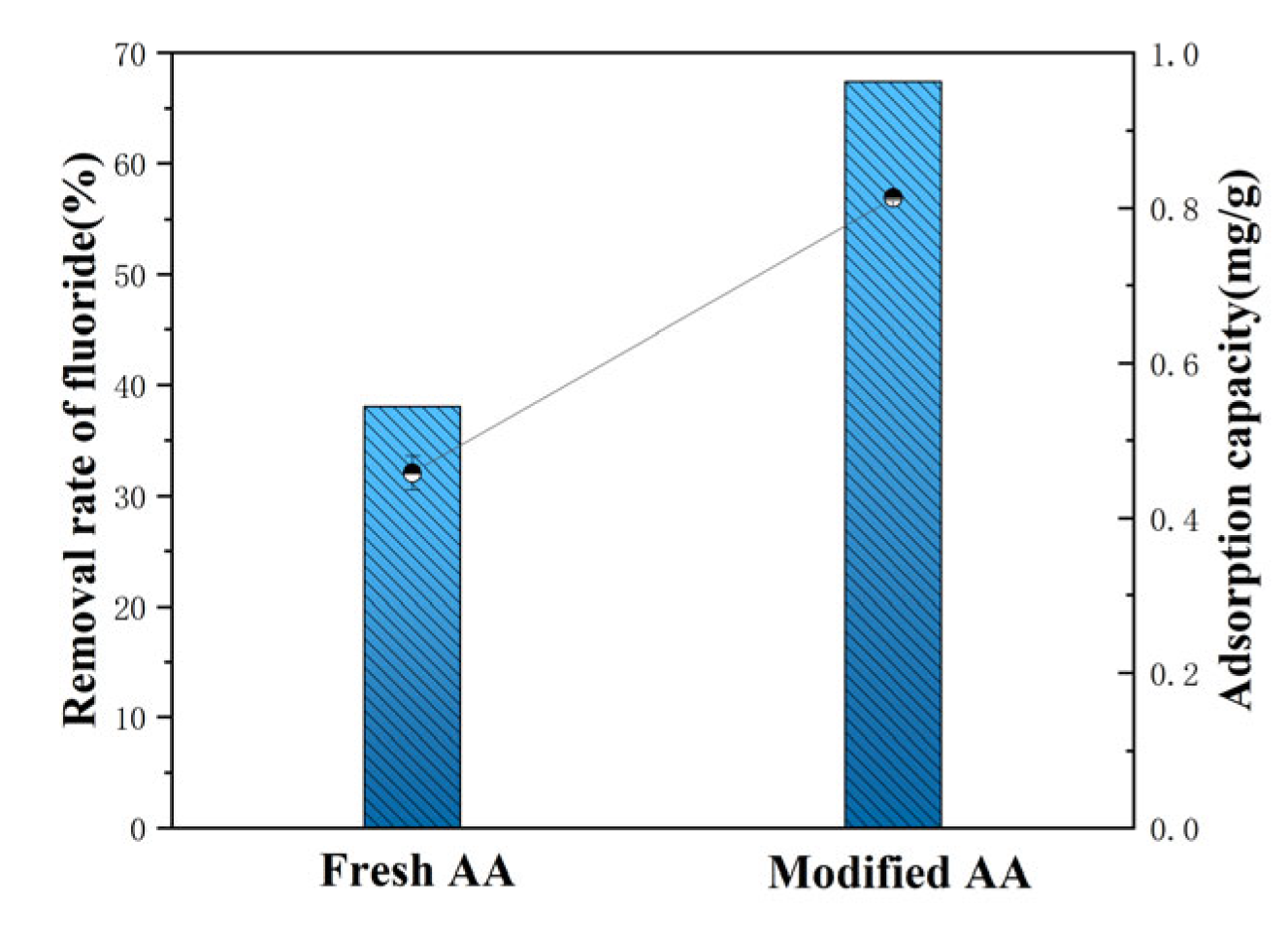
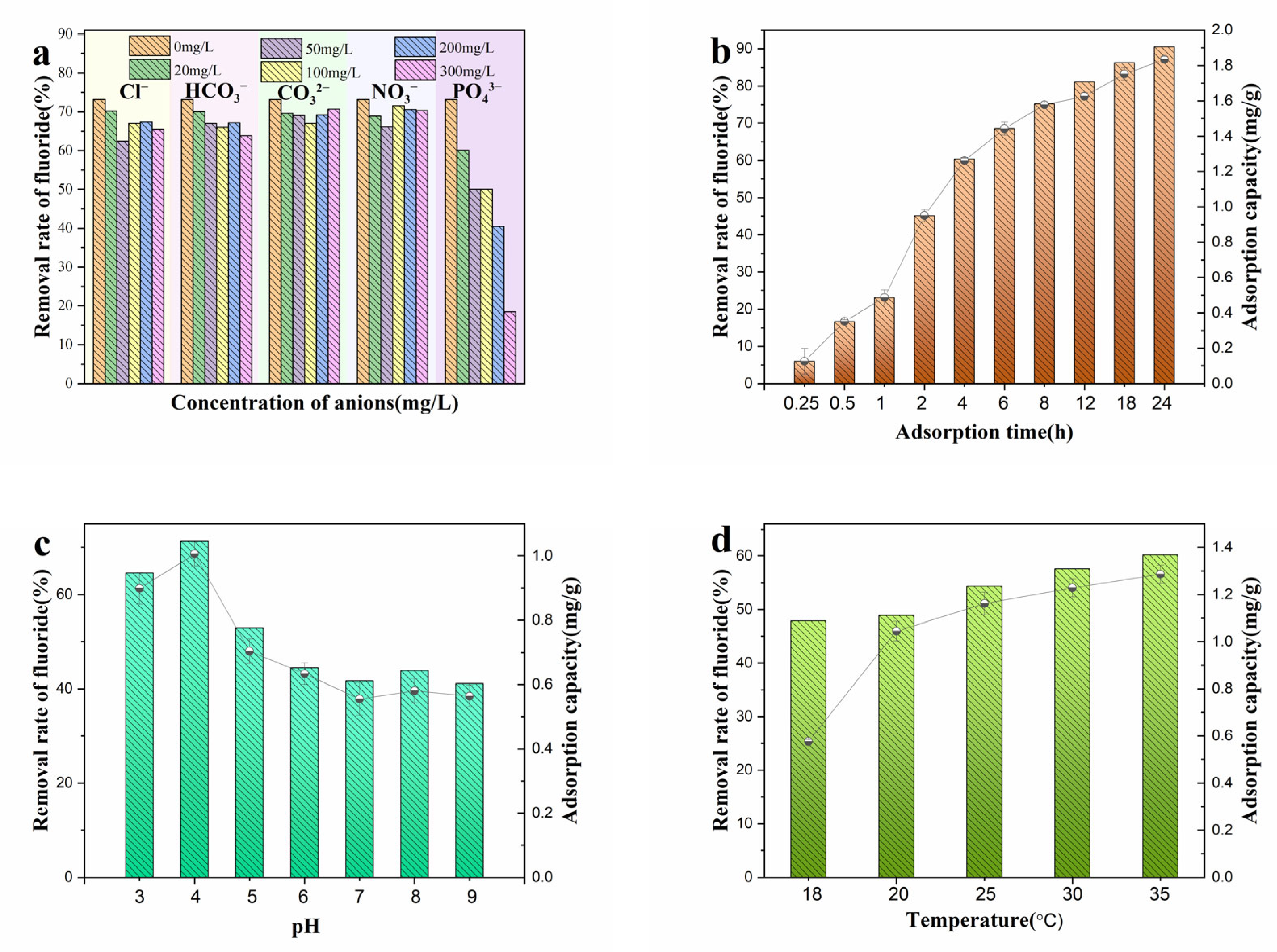
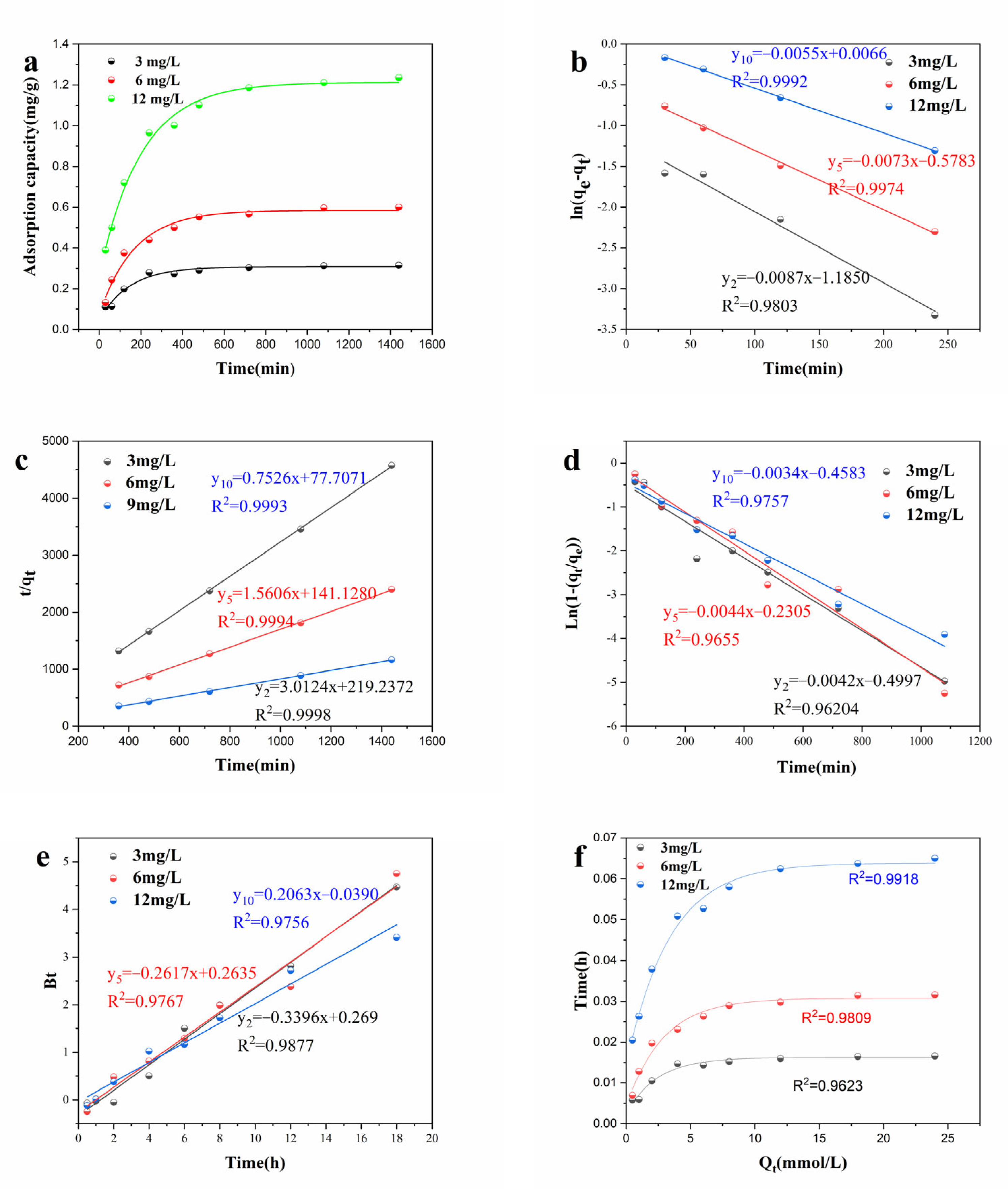
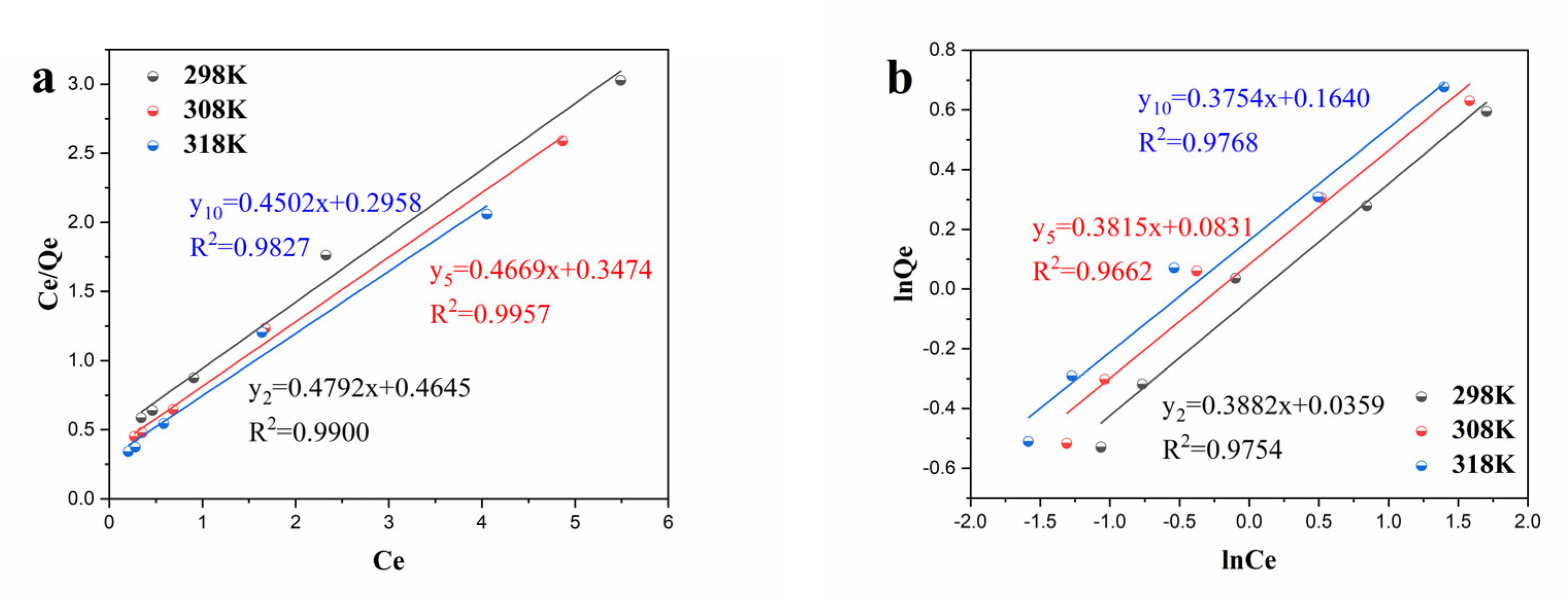
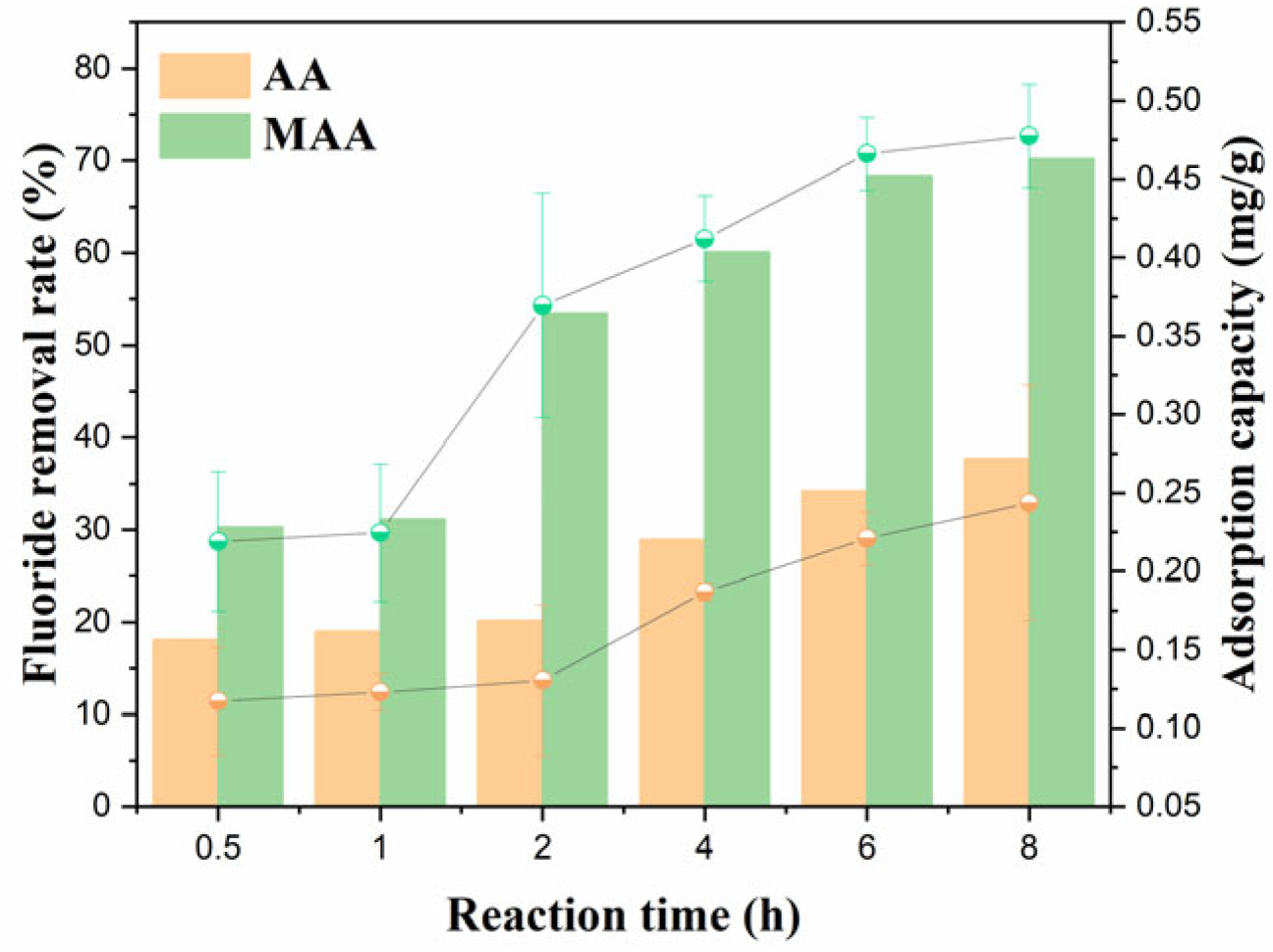
Publisher’s Note: MDPI stays neutral with regard to jurisdictional claims in published maps and institutional affiliations. |
© 2022 by the authors. Licensee MDPI, Basel, Switzerland. This article is an open access article distributed under the terms and conditions of the Creative Commons Attribution (CC BY) license (https://creativecommons.org/licenses/by/4.0/).
Share and Cite
Gao, Y.; You, K.; Fu, J.; Wang, J.; Qian, W. Manganese Modified Activated Alumina through Impregnation for Enhanced Adsorption Capacity of Fluoride Ions. Water 2022, 14, 2673. https://doi.org/10.3390/w14172673
Gao Y, You K, Fu J, Wang J, Qian W. Manganese Modified Activated Alumina through Impregnation for Enhanced Adsorption Capacity of Fluoride Ions. Water. 2022; 14(17):2673. https://doi.org/10.3390/w14172673
Chicago/Turabian StyleGao, Yujia, Kun You, Jinxiang Fu, Juliang Wang, and Weiyi Qian. 2022. "Manganese Modified Activated Alumina through Impregnation for Enhanced Adsorption Capacity of Fluoride Ions" Water 14, no. 17: 2673. https://doi.org/10.3390/w14172673
APA StyleGao, Y., You, K., Fu, J., Wang, J., & Qian, W. (2022). Manganese Modified Activated Alumina through Impregnation for Enhanced Adsorption Capacity of Fluoride Ions. Water, 14(17), 2673. https://doi.org/10.3390/w14172673




